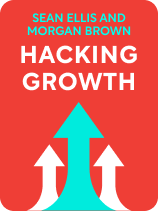

This article is an excerpt from the Shortform book guide to "Hacking Growth" by Sean Ellis and Morgan Brown. Shortform has the world's best summaries and analyses of books you should be reading.
Like this article? Sign up for a free trial here.
What exactly is meant by “customer development”? What are the four stages of the customer development process?
Customer development refers to how you take your customers from signing up to staying loyal for the long term. “Developing” a customer means crafting an experience, from top to bottom, that gets and keeps your customers excited and engaged by your product.
Let’s look at the four phases of the customer development process—getting customers to sign up, stick around, stay loyal, and spend money.
1. Signing Up: Hack Your Marketing
The first step in Sean Ellis and Morgan Brown’s customer development process is to hack your customer acquisition. This involves two main steps:
- Step #1: Find your language and market fit: Craft appealing language in your marketing materials that gets people to try your product.
- Step #2: Find your channel and product fit: Find the best marketing channel for your product and optimize it for growth.
Language and Market Fit
The authors explain that users’ attention spans are shorter than ever—down to eight seconds—so you must craft concise, compelling language that immediately gets across how your product will improve the user’s life. (Note that you should already know your target market; this fit is about refining your language to appeal to it.)
According to the authors, doing this is as simple as running A/B tests. An A/B test means creating two different versions of the same component of a page—such as the header of an article—and measuring how users respond to each. This allows you to test for which language, fonts, colors, graphics, and overall page designs are more effective. Run these tests throughout your product and marketing materials to optimize your language/market fit.
Channel and Product Fit
A channel is a way (and place) to market to your customers, such as through Facebook ads, Google search results, business trade shows, or YouTube sponsorships. The authors recommend focusing first on one channel that makes the most sense for your business.
To find that channel, consider which channels make sense for your business, then narrow those down to one. For instance, a SaaS company with mainly young, online customers would consider paid Google search ads, Facebook ads, email marketing, and content marketing. In contrast, a B2B (business to business) hardware company might prioritize conferences and trade shows.
2. Sticking Around: Hack Your User Experience
Once you’ve acquired customers, the next challenge is getting them to stick around. According to the authors, to retain customers, you must make it easy for them to experience the core value of your product. Follow the authors’ three steps to do this:
- First, map the steps to your click moment: Identify each step users must take to reach the core value of your product—everything from signing up and payment to product tutorials.
- Next, measure how far people get toward that moment: Analyze your data and create a report that shows how many users “bounce” (leave the website) at each step.
- Then, survey your users: Reach out to users who did and didn’t drop at each step. Ask those who left what caused them to bounce, and ask those who stayed why they stuck around.
These three steps give you a clear picture of what you can adjust to get more users to reach your product’s core value. According to the authors, you often need to reduce friction—things that slow down or complicate the process—to get more users to follow through.
The authors recommend two core strategies to reduce friction and optimize for user engagement:
Strategy #1: Optimize your new user experience (NUX)—First, eliminate friction in your new user experience. A bad NUX causes customers to bounce, whereas a good NUX helps users see how your product can become a valuable part of their daily lives. The authors recommend running growth hack experiments on your NUX’s landing page, language, aesthetics, and any steps the users have to take. They also suggest trying single sign-on (using an existing account with a major tech company to quickly create a new one) and/or giving users a free trial that highlights the core value of your product.
Strategy #2: Use triggers to keep users coming back—Triggers are prompts that get people to respond or react in some way. These include push notifications, emails, and calls to action. Whatever triggers you use, make sure they concisely remind the user of your product’s value or alert them to a new feature or upgrade. According to the authors, you can use triggers to get users to form a habit of using your product. However, be aware that people are targeted by endless triggers today. If you overdo it or lack finesse, customers might think you’re annoying or even sleazy and corrupt.
3. Staying Loyal: Hack Your Retention
Once you’ve acquired and engaged customers, you need to retain them. According to the authors, retention determines a company’s success over time. If you can’t keep your customers, you won’t stay profitable. Retaining users involves analyzing what causes users to leave and optimizing to reduce those factors.
First, break down your users into cohorts. A cohort is a group of users identified by a shared trait. You can divide cohorts by age, location, gender expression, educational status, and so on. The authors recommend starting with a cohort for each month’s customers: People who join in January are the “January cohort,” and so on for each month. This allows you to track retention by month and analyze users to find patterns in the behavior of those who leave. Knowing those behaviors, you can look for ways to change your user experience and reduce the losses. There are three areas of retention to work on: initial, middle, and ongoing retention.
#1: Initial retention—Immediately beyond your NUX, prompt customers to come back and continue to use your product. The authors recommend using triggers such as emails and notifications to prompt users to return. Apply the growth hacking cycle to optimize the language and presentation of these triggers and product experiences.
#2: Middle retention—Once the customer has opted to return, keep them engaged. You can do this with a variety of tactics, including loyalty programs, product ambassador programs, by offering in-app perks for regular use, and so on. The authors suggest rewarding your customers for using your product so they’ll form a habit of doing so. When a user forms a habit, your product will become a regular part of their life. In turn, they’ll keep paying for the service.
#3: Ongoing retention—Last, get customers to stick around for the long haul. The authors stress that you must continually introduce new features to keep your product competitive and valuable. To do this, talk to your customers to get feedback and build your product to serve their wants and needs. You can also use cohort analysis to find the features people use most and experiment with improving those. According to the authors, it’s important that you find a steady testing pace that doesn’t bother existing users. People get attached to what they like, but they’ll embrace changes if they come a little bit at a time.
4. Spending Money: Hack Your Pricing
According to the authors, maximizing the amount of money you get from each customer is key to your business’s profitability over time. Growth hacking can help you increase revenue by optimizing your sales funnel and your pricing.
As before, start by setting up your data. Create a “customer journey” funnel that tracks each point in your sales funnel, and gather data on where users stick or bounce versus where they flow through to the sale. Then analyze your users’ behaviors and then reach out with surveys to find correlations between where you lose customers and the steps in your sales process.
With these insights in mind, start generating ideas to adjust your sales funnel. Then, test out one idea at a time to reduce friction and decrease the number of customers that bounce from your funnel. The authors explain that you should experiment slowly and incrementally, and avoid spooking your customers with aggressive sales pitches or marketing tactics.
Follow the same technique to optimize your pricing: Combine analyses of user behavior and surveys to get a sense for what customers are willing to pay. Then, experiment by testing out different price points on different segments of your user base within the range they’re willing to pay. The authors also recommend using pricing psychology tricks, such as including prices that end in .99 or .95, and using dummy prices—prices that bundle together a basic and advanced version of your product at a slightly lower price than the highest price point. This will get customers to spend more, thinking they’re getting the best deal by buying the bundle, at no extra cost to you.

———End of Preview———
Like what you just read? Read the rest of the world's best book summary and analysis of Sean Ellis and Morgan Brown's "Hacking Growth" at Shortform.
Here's what you'll find in our full Hacking Growth summary:
- Why the old approaches to marketing no longer work in a high-tech world
- How to rapidly increase your revenue and grow your business
- A step-by-step guide on how to use the growth hacking method






